The History Of DAF

DAF Trucks NV is a Dutch truck manufacturing company and a division of PACCAR. Its headquarters and main plant are in Eindhoven. Cabs and axle assemblies are produced at its Westerlo plant in Belgium. Some of the truck models sold with the DAF brand are designed and built by Leyland Trucks at their plant in England.
In 1928 Hubert "Hub" van Doorne founded the company as Commanditaire Vennootschap Hub van Doorne's Machinefabriek. His co-founder and investor was Huenges, managing director of a brewery. Van Doorne had repaired Huenges's car several times. Huenges was so pleased with his work that he offered to lend him money if he wanted to start for his own. Hub started to work in a small workshop on the grounds of the brewery. In 1932 the company, now run by Hub and his brother, Wim van Doorne, changed its name to Van Doorne's Aanhangwagen Fabriek (Van Doorne's Trailer Factory), abbreviated to DAF. Huenges left the company in 1936 and the DAF company was now completely in the hands of the van Doorne brothers.
After the Second World War, luxury cars and trucks were very scarce. This meant a big opportunity for DAF. In 1949 the company started making trucks, trailers and buses, changing its name to Van Doorne's Automobiel Fabriek (Van Doorne's Automobile Factory). The first truck model was the DAF A30.
In the winter of 1954 Hub van Doorne had the idea to use belt drive, just like many of the machines in the factory that were belt-driven, to drive road vehicles. In 1955 DAF produced its first drafts of a car belt drive system. Over the next few years the design was developed and refined. In February 1958 DAF demonstrated a small belt-driven four-seater car at the Dutch car show (the AutoRAI). The public reaction was very positive and 4000 cars were ordered. In 1959 DAF started selling the world's first car with a continuously variable transmission, the small four-seater DAF 600. This was the first of a series of models to be released in subsequent years, including the DAF 33, DAF 44, DAF 55 and DAF 66, all using the innovative Variomatic transmission system.
In 1967 DAF opened a new plant in Born for car production. The 44 was the first model to be produced there.
In 1972, International Harvester of Chicago, IL bought a 33% stake in DAF (with the Dutch government holding 25% and the Van Doorne family holding the remaining 42%), forming a joint-venture. This agreement lasted until 1981.
DAF sold its passenger car division, along with what is now the NedCar factory in Born, in 1975 to the Swedish company Volvo Cars, leaving DAF to concentrate on its successful line of trucks.
In 1987 DAF merged with the Leyland Trucks division of Rover Group, and was floated on the Dutch stock exchange as DAF NV. The new company traded as Leyland DAF in the UK, and as DAF elsewhere.
DAF's successful 95 series was introduced in 1988, bringing DAF their first International Truck of the Year title. The 95 brought new levels of driver comfort,(particularly with the high-roof space cab variants) with ample space inside the well sprung cab. It featured DAF's well proven 12 litre I6 ATi (advanced turbo intercooling) engine in 310,350,360,400 and 430 hp outputs, coupled to a ZF 16 speed range change/ splitter gearbox. The basic cab design was so good that it remains in production to this day, latterly as the 95XF and now the XF105, although both these "developments" of the original 95 are totally different machines under the skin. Other vehicles in the DAF range have included the inherited from Leyland trucks 7.5 ton 45, the cab of which was used in the up to 18 ton gross 55, the 65,75 and 85 which all used the same cab, the 85 the highest powered of the three and designed as the maximum weight variant. A short-lived model was the 1990-93 DAF 80, which made use of the T45 Roadtrain cab acquired from the Leyland trucks takeover, fitted with Daf's own 330 ATi engine.
DAF Bus was split off of in 1990 to become a part of United Bus.
Following difficulties in the British market, DAF NV went bankrupt in 1993. A new company, DAF Trucks, appeared in the Netherlands as a result of a management buy-out of the Dutch operations, as did Leyland Trucks and LDV (vans) in the UK.
In 1996 PACCAR acquired DAF Trucks. Interestingly, DAF Trucks and Leyland Trucks came together again in 1998 when PACCAR also acquired Leyland Trucks.
Car business
The first passenger car, assigned the model number 600, created a sensation when a prototype was presented in 1958. The car featured a unitary steel construction, with a front mounted, aircooled two cylinder boxer engine driving the rear wheels through a centrifugal clutch and the Variomatic CVT transmission. The way this was constructed eliminated the need for a differential, with the drivebelts taking up the difference of speed in the corners. This acted as a limited slip differential. The car had independent suspension all round, with McPherson struts and a transverse leaf spring at the front, and a coil sprung semi trailing arm design at the rear. The first 600s rolled off the production line in the following year. The next model was the 750, featuring a larger 749 cc twin.
Later, DAF produced a more luxurious type called the Daffodil, divided into three models assigned the numbers DAF 30, DAF 31 and DAF 32. The designation 32 was changed to 33 upon the 1966 release of the 44, a larger middle-class vehicle designed by Michelotti. The 44 featured a completely new design aesthetically as well as mechanically, but was of the same layout as the "A-type's" (the 600,750,30,31,32 and 33), with the main difference being its 850 cc two cylinder engine, and its full swingaxle rear axle design as opposed to the A-type semi-trailing arms.
The 1968 DAF 55 carried a bigger watercooled 1108cc OHV four cylinder engine derived from the Renault 8 Cleon engine. Its body design was altered from the 44 by a new front which accommodated the longer engine and radiator, bigger taillights, and a more plush interior. The front suspension was changed from a transverse leaf spring to McPherson struts with torsion springs and an antiroll bar.
The DAF 66 was introduced as a successor to the 55. It featured new, boxy styling of the front, and a new rear axle design. The two drive belts now powered a differential, and the axle was changed from a swingaxle design to a leaf sprung de Dion-axle. It was a major improvement over the (tricky) handling of the swing axles of the earlier 33,44 and 55 models.
Volvo gained a large interest in DAF in the early '70s, taking over the company and the NedCar plant in 1975. It dropped the 33 and 44 models, and rebadged the DAF 66 as the Volvo 66, with bigger bumpers and a safety steering wheel. The DAF 46 was developed under Volvo, and was basically a 44, with the rear axle of a 66 and a single-belt variomatic (half the 66's transmission). The Volvo 300 series, introduced in 1976 had been designed as a DAF, with a Variomatic transmission similar to that of a 66.
Prototypes and special cars
For a small company, DAF made a huge amount of prototypes. Also, famous coach builders like Michelotti and OSI made cars based on the DAF technique. For instance, the OSI City Car, which turned into a miniature. DAF's last prototype, the DAF 77, became the Volvo 343, which sold about 1.3 million units.
Truck business
DAF produced their first truck, the A30, in 1949. This truck was upgraded in the following years. Their first attempt into the international market was a failure, the 2000DO. Their next truck was the 2600, which became a big seller. They also produced a so-called torpedo-front tractor.
In the 1970s a new cab style was introduced on the 1700/ 1900/ 2100/ 2300/ 2500/ 2800/ 3300/ 3600 range of vehicles, which featured DAF's characteristic 3-piece windscreen. The design lasted until the introduction of the 85 style cab in 1993. DAF was also one of the first to introduce a turbocharged diesel engine into their trucks, which in these years became very evident with their 3600.
There is a DAF LF45 hybrid version.
Cars
DAF cars had the image of being slow. The company tried to change this image with entries in rallies and races, such as their entry in the London-Sydney Marathon. This led to an increase in sales, but not as much as the management had hoped for. The company also competed with a Formula 3 car.
- 1993: A Williams Formula 1 car was not allowed to race, because it had the Van Doorne's CVT drive.[citation needed] If that car had raced, it could have been more than a full second per lap faster than the competition.[citation needed] As Williams was the leading team already at the time, the F1 management decided to forbid the technology. It would have been the first time a technical development introduced in a road car would be used in a race car, instead of the other way round.[citation needed]
Trucks
- 1980s: DAF trucks started with the Dakar Rally, winning in 1982, 85 and 87. In the later years, they had a twin engine truck, with a combined power output of more than 1,000hp (700kW).
- 1988: Two trucks were entered into the Paris-Dakar rally. Jan de Rooy's truck was at a certain stage at the third place overall (!), beating the Peugeot 405 T16's on speed. The other truck, driver by Cees Van Loevezijn, was involved in a crash in which he died, and almost taking the lives of the other 2 occupants of the truck. DAF withdrew.
- 1996: DAF started competing in the European Truck Race series, first not very successful, but by 1999 almost champion. To everyone's surprise, they withdrew.
- 2002: DAF competed in the Dakar Rally, with Jan de Rooy and his son Gerard. It was a learning year.
- 2003: DAF competed in the Paris-Dakar rally, winning numerous stages, but Gerard crashed out and Jan had a lot of problems.
- 2004: DAF competed in the Paris-Dakar rally, powering six racetrucks. Jan en Gerard de Rooy, the team Tridec, The team Hans Bekx with 2 teams and the GINAF Rally Power team (Note that 4 trucks were built by DAF, 2 by GINAF).
- 2005: Hans Bekx almost became second overall in the truck division, before being thrown out of the list because of an irregularity, something which the (especially Dutch) racing fans could not imagine.
- 2006: Jan and Gerard de Rooij were excluded from the Dakar because of paperwork issues. Numerous rumours claim that the Kamaz team has used its influence in the Dakar organisation in this matter. It led to a huge fall in popularity of the event in the Benelux.
- CF series
- XF series
- LF series
From Wikipedia, the free encyclopedia
More About DAF
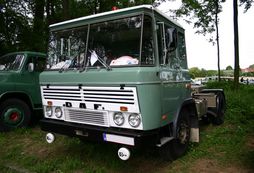
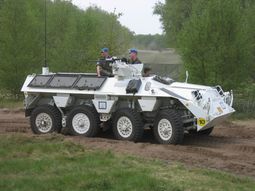
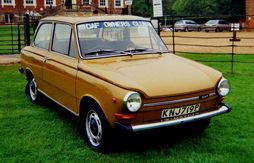
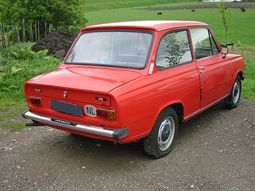
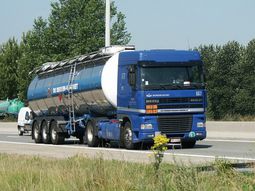
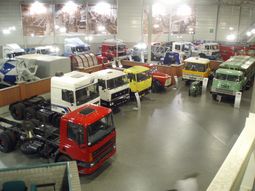
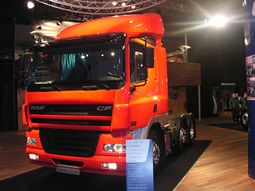
|